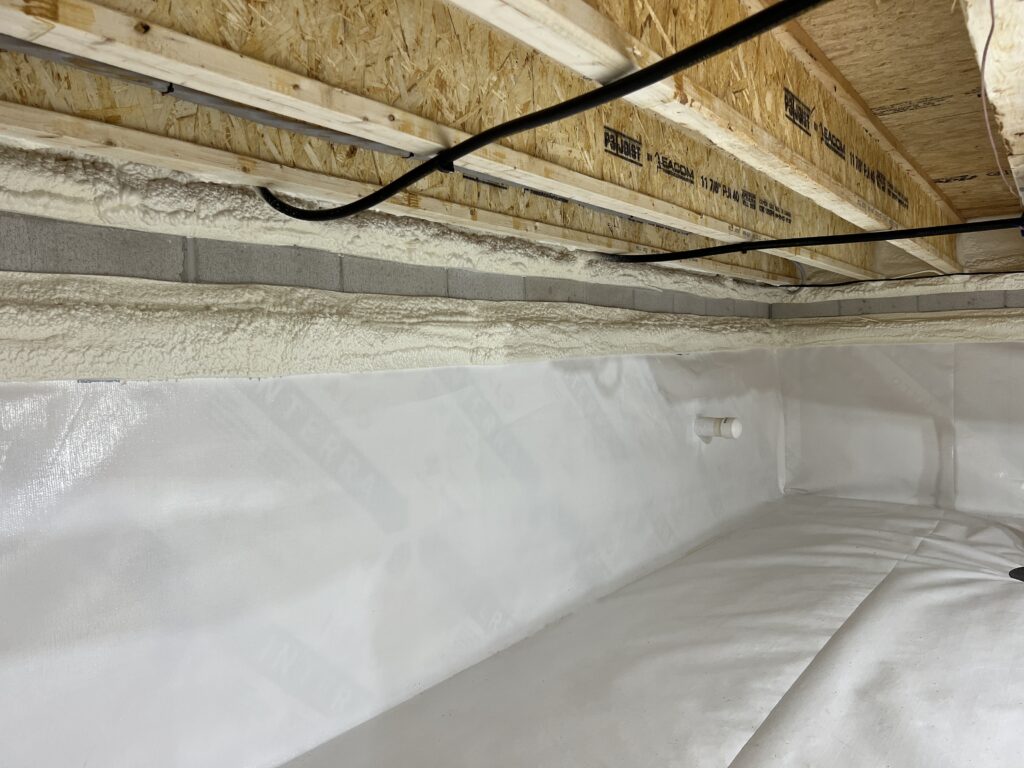Closed Cell Foam Insulation
Our Process
Closed-cell foam in a crawl space is commonly used as an insulation and moisture control solution. This is a closed-cell polyurethane foam that is applied to block walls and perimeter band wood joist. Applied at 1.5” thick for an R11 value for a continuous air-tight seal. A 4” strip is left exposed near the top of the block for termite inspection. It is applied in areas where relative humidity levels exceed 55%. Our Liner is applied a minimum 16” up onto walls. This foam is used to seal the top of our liner to the block wall because of its glue type properties and air-tight seal. This foam is waterproof so any dampness in foundation block will not disturb or break down the foam over time.
Due to the materials and process of the spray foam application and per the manufacturer of these materials it is recommended to vacate an occupied dwelling for up to 24 hours while the application is being done. It is also recommended to shut down your HVAC system during and 1-hour AFTER the application of the foam spray. Over the last 15 years Delaware Crawlspace Company has utilized this foam application and it’s important to know there haven’t been any issues during the foam application. However, we like to inform our clients about the full details of our installation.


What is Closed-Cell Foam?
Closed-cell spray foam is a type of polyurethane foam insulation that, when applied, expands and hardens into a dense, rigid layer. The “closed-cell” refers to the structure of the foam, where the cells (or bubbles) within the foam are completely sealed, making it much more effective at resisting water and air infiltration compared to open-cell foam.
Benefits of Using Closed-Cell Foam in a Crawl Space
- Moisture Barrier: Closed-cell foam is highly resistant to moisture. It can effectively block water vapor from entering the crawl space, which helps to prevent mold, mildew, and wood rot, all of which can damage the structural components of the house.
- Air Sealant: The foam creates an airtight seal when applied to walls, floors, and the underside of the subfloor. This helps reduce drafts, air leakage, and energy loss, improving the overall energy efficiency of the home.
- R-Value: Closed-cell foam has a high R-value (thermal resistance), typically around R-6 to R-7 per inch of thickness. This makes it an effective insulator, helping to keep the crawl space warmer in the winter and cooler in the summer.
- Structural Support: The rigidity of closed-cell foam can add a bit of structural strength to the crawl space, particularly when it’s applied to foundation walls. It can help prevent bowing or cracking over time, which can sometimes occur in older homes.
- Pest Control: The foam can act as a barrier to pests like insects, rodents, and termites, which may be trying to access the crawl space for shelter or food.
Application Areas in a Crawl Space
- Crawl Space Walls: Closed-cell foam is often applied to the foundation walls to seal off the space from external moisture and to provide insulation. This is a common approach for homeowners who want to keep the crawl space dry and energy-efficient.
- Subfloor Insulation: Some people also apply closed-cell foam to the underside of the subfloor (the floor above the crawl space) to prevent heat loss and minimize moisture infiltration from below. This is especially useful in colder climates to keep the floors warmer.
- Crawl Space Floor: Although less common, closed-cell foam can also be used on the floor of the crawl space, particularly if there is a need for both insulation and moisture control. In this case, it’s usually applied in combination with a vapor barrier.
Installation Process
- Surface Preparation: Before applying closed-cell foam, the surfaces in the crawl space need to be cleaned and prepped. This may involve removing debris, dirt, or old insulation, and addressing any existing moisture or mold problems.
- Spraying the Foam: Once prepared, the foam is sprayed onto the surfaces in a thick, even layer. It then expands and hardens, forming a seamless, moisture-resistant, and insulating barrier.
- Curing and Inspection: After the foam has been applied, it needs time to cure and harden fully. Once it’s set, a Delaware Crawl Space professional will inspect the job to ensure the coverage is complete and that there are no gaps or weak spots.
When to Use Closed-Cell Foam
- Excessive Moisture Issues: If your crawl space has high humidity, moisture problems, or standing water, closed-cell foam can be a good choice to keep moisture out and protect the structure.
- Energy Efficiency Concerns: If your home has high energy bills due to poor insulation in the crawl space, closed-cell foam can significantly reduce heat loss and air leakage, helping to lower utility costs.
- Conditioned Crawl Spaces: If you are converting your crawl space into a more usable, conditioned space (e.g., a living area, storage, or a home office), closed-cell foam is an excellent choice for insulation and moisture control.
Long-Term Performance
Closed-cell foam can last for many years without significant degradation. It doesn’t shrink, sag, or settle over time, and it maintains its insulating and moisture-blocking properties for the long term.
